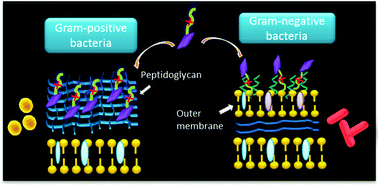A purpurin-peptide derivative for selective killing of Gram-positive bacteria via insertion into cell membrane†
Abstract
Pathogenic bacteria can cause significant morbidity and become a critical public healthcare problem. To date, effective identification and killing of bacteria remains a major challenge in bacterial infections. Although numerous materials have been designed for bacteria identification, few materials can discriminate different bacteria effectively. In this work, we designed a new polyarginine chlorophyll derivative (PA7) that can identify different bacteria successfully. PA7 was composed of a cationic hydrophilic chain and a hydrophobic purpurin-18 core and had variable binding capabilities towards different bacteria based on their surface components and structure. We observed that the PA7 molecule preferentially bound to Gram-positive bacteria (i.e., S. aureus) over Gram-negative bacteria (i.e., E. coli) through CLSM imaging. Furthermore, ζ potential experiments indicated that the binding ability of PA7 to Gram-negative (E. coli) was more susceptible to the ionic strength. Given the fact that the two kinds of bacteria possess different cell envelope components, we speculated that the binding of PA7 to S. aureus was dominated by electrostatic and hydrophobic interactions, and only electrostatic interactions for E.coli. Moreover, PA7 could be used as a good photoacoustic contrast agent. PA7 could discriminate Gram-positive bacteria and Gram-negative bacteria via photoacoustic imaging in a buffer solution with variable ionic strengths. Effective killing of bacteria was another motivation of the molecular design. PA7, as a potential photosensitizer, exhibited a much higher photodynamic antibacterial activity to S. aureus.


 Please wait while we load your content...
Please wait while we load your content...